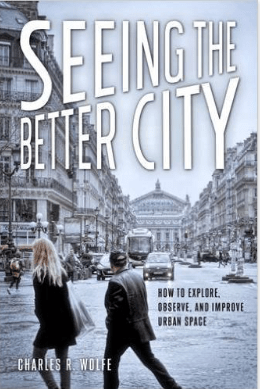Chuck Wolfe’s book has been shortlisted for a 2018 UK National Urban Design Award.
Our Visiting Scholar Charles R. Wolfe´s 2017 book, Seeing the Better City (Island Press) has the chance to win the UDG Award in London.
Seeing the Better City: How to explore, observe and improve urban space

Of the millions of photos that are taken every day, it is safe to say that most are not used in any more than a consumptive way. Here, Charles R Wolfe, Seattle-based practising attorney of land use and environmental law, proposes a much more analytical and tool-based use of images. This is intended as a counterweight to typical regulatory planning language that struggles to engage people meaningfully, and in a way that properly reflects our multi-faceted and increasingly diverse urban world. A ‘place ethnography’ – the interrelationship of society and environment - across multiple disciplines; a guide to observing the city more clearly; to experience through what we see; to under-stand and capture moments; to articulate, organise, manage and apply change; and, to create the places of our dreams, through insights, patterns and tools with an intent to improve – a place-led future.
With a reasonable number of photographs throughout, mostly black and white but with some colour, photos are used to supplement the text. Chapters are arranged as: How to see city basics and universal pat-terns; Observational approaches; Seeing the city through urban diaries; Documenting our personal cities; From urban diaries to poli-cies, plans, and politics; and, Conclusion: what the better city can be.
The use of the ‘urban diary’, including Placecheck’s Walkabout-type prompts, and the desired social and physical outcomes, in conjunction with photos, allows him to better capture the essence of a place, the ‘environments at the urban scale of size, time, complexity’. In turn this helps to foster dialogue and make more refined and nu-anced recommendations and changes, to genuinely reflect the fine-grained texture and rhythms of the places where we live, so that our rules and regulations actually serve us. Further, it allows to recognise that ‘the degree to which liveability derives from cultural tradition is somewhat variable, but such organic urban development is readily discernible, independent of government intervention, policy or plan’.
To achieve this requires us to not necessarily just take time, although patience really is a virtue and often a rewarding one in this context, but to be open to really seeing the rhythms, mini-events and subtle processes going on around us, from the more obvious ‘viewable factors’ to the flaneur’s ‘everything too subjective for professionals to credit’. Despite our constant efforts to the contrary ‘the very nature of our relationships to urban places inherently lacks precision’. Contradic-torily our efforts to plan and regulate is all too often rendered in language that is vague and lacking clarity.
These two situations then give us a lan-guage and intention at odds with each other. If we observed more astutely using all of our senses and used that richness and precision to put propositions into a clear, simple but inspiring language (including photos), we could perhaps achieve a way to improve our everyday urban environments in a way that is engaging for all involved and true to the complex and often messy nature of where we live.
text: Marc Furnival
